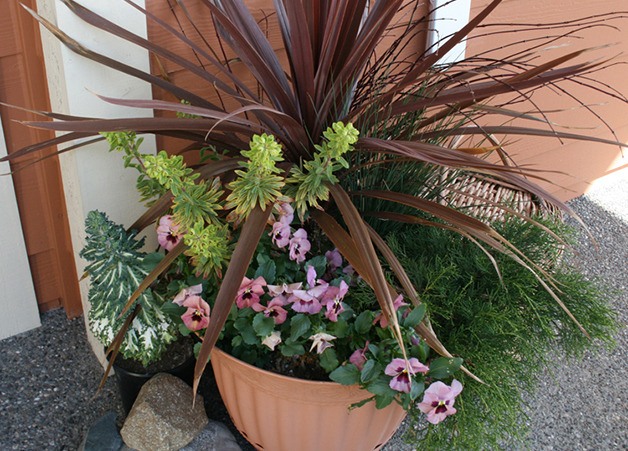By Pamela Wickard
Snoqualmie Valley Master Gardener
No matter what you want to plant – salad makings, welcoming front porch plants or a screen for your patio, you can plant some version of it in a container. All you need is an appropriate container and some soil.
A successful container garden starts with good potting soil, complete with ample nutrients and good drainage. Certain materials will affect fertility and have an impact on drainage, so start with a soil that is labeled potting soil; if it has compost in it, even better. Then you’ll need some slow-release fertilizer.
Just about anything can be used as a container. There are the conventional ceramic, terra cotta or wood, but why not try an old wagon, hiking boots, baskets or a colander. Just make sure there are holes for ample drainage. Avoid the suggestion to put gravel in the bottom of your container to increase drainage. It doesn’t work, and in fact is counter-productive, taking up valuable soil and roots space. Also, if it’s a large container, think about how you will move it before you add soil and plants. For extra-large containers, try filling the bottom half with empty gallon milk jugs. Just make sure to leave plenty of space for soil.
Now the fun part, the plants. When you’re choosing plants for your container, make sure that they are “like” plants, with the same needs (sun, water and nutrients). Consider the site where you want the container to be located (sun or shade). Most containers will require daily watering, in the warmer months; just check the container first before watering. Then make sure all the plants in one container need and like the same conditions; combining plants with different needs will allow for some to suffer while others thrive. The plant label will usually give you this information; nursery or garden center staffs are a wealth of knowledge as well – just ask.
The three key elements in a successful container design are simple. You’ll need, 1) the Thriller, 2) the Filler, and 3) the Spiller. This recipe works every time. It’s also important to consider leaf texture, color and size. Try to vary each. You can get even more creative by adding in a splash of color from assorted annuals, like the pansies pictured above. Happy planting!
Additional information on weeds can be found at www.svmastergardeners.com. Bring your gardening questions to the Snoqualmie Valley Master Gardeners at the Nursery at Mt. Si on most Saturday mornings through mid-June, and then at the North Bend Farmers Market.
• Wickard is a master gardener in the WSU Extension Master Gardener Program.


